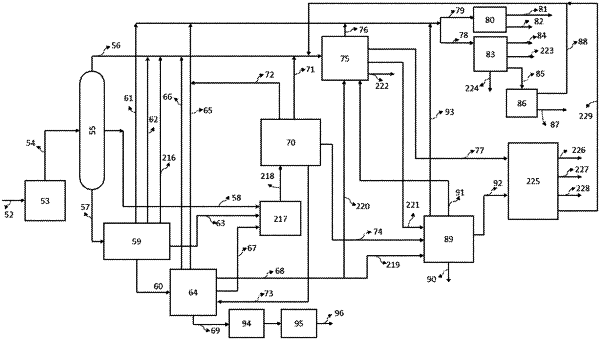| CPC C10G 67/16 (2013.01) [C10G 67/02 (2013.01); C10G 69/14 (2013.01); C10G 2300/1033 (2013.01); C10G 2300/301 (2013.01); C10G 2300/4006 (2013.01); C10G 2300/4012 (2013.01); C10G 2300/4025 (2013.01); C10G 2300/4081 (2013.01); C10G 2400/20 (2013.01); C10G 2400/30 (2013.01)] | 18 Claims |

|
1. A process for converting a crude oil to high value petrochemicals products, the process comprising:
i. charging the crude oil to a Desalter unit to obtain a desalted crude oil;
ii. fractionating the desalted crude oil in a primary fractionation section to obtain straight run fractions, wherein the straight run fractions comprise an upper Light cut having a boiling point below 350° C., a Middle cut having a boiling point in a range of 350-560° C. and a Lower heavy cut having a boiling point above 560° C.;
iii. routing the Lower heavy cut to a first Resid upgradation unit to obtain Fuel gas (FG) and LPG, Naphtha having a boiling point in a range of C5 to 140° C., Light Gasoil (LGO) having a boiling point in a range of 140-370° C., Heavy Gasoil (HGO) having a boiling point in a range of 370-560° C. and unconverted Pitch having a boiling point above 560° C. by Residue Slurry Hydrocracking;
iv. routing the Middle cut from Primary fractionation section HGO from the first Resid upgradation unit and Heavy Coker Gas oil (HCGO) from a second Resid upgradation unit to a Hydrotreater Unit to obtain a combined Hydrotreated Gasoil stream;
v. routing the combined Hydrotreated Gasoil stream to a High severity Fluid Catalytic Cracking Unit (FCCU), to obtain FG, LPG, Naphtha having a boiling point in a range of C5 to 210° C., Light Cycle Oil (LCO) having a boiling point in a range of 210 to 340° C., and Clarified oil (CLO) with a boiling point above 340° C.;
vi. routing the unconverted Pitch from the first Resid upgradation unit and CLO from the FCCU to the second Resid upgradation unit for Delayed Coking reactions to obtain FG, LPG, Coker Naphtha with a boiling point in a range of C5 to 140° C., Light Coker Gas oil (LCGO) having a boiling point in a range of 140 to 370° C., Heavy Coker Gas oil (HCGO) having a boiling point in a range of 370 to 540° C. and Coke;
vii. withdrawing a part of the Coke as high value Coke product and routing the remaining Coke to a Coke Gasifier unit where it is converted to syngas, and syngas is converted to olefins using Syngas to Methanol (STM) and Methanol to Olefins (MTO) processes;
viii. splitting the LCGO stream from the second Resid upgradation unit into two parts on a mass ratio without altering boiling range (140-370° C.) and routing a first part along with the Light Cycle Oil from the high severity FCC unit and Light Cycle Oil having a boiling point in a range of 210 to 340° C. recycled from a Catalytic Naphtha Cracker unit, to a Selective Mild Hydrocracking unit (SMHC) to obtain Fuel Gas, LPG, a Light cut having a boiling point in a range of C5 to 90° C., a Middle cut having a boiling point in a range of 90 to 180° C. and a Bottom cut having a boiling point above 180° C.;
ix. routing the upper Light cut having the boiling point below 350° C. from Primary fractionation section, the Naphtha having the boiling point in the range of C5 to 140° C. from the first and the second Resid upgradation units, the Light cut having the boiling point in the range of C5 to 90° C. from the SMHC unit, the LGO from the first Resid upgradation unit, the Naphtha having the boiling point in the range of C5 to 210° C. from the FCCU and a second part of the LCGO stream from the second Resid upgradation unit to a Catalytic Naphtha cracker unit to obtain FG, LPG and Gasoline having a boiling point in a range of C5 to 210° C., Light Cycle Oil having a boiling point in a range of 210 to 340° C. and Clarified oil (CLO) having a boiling point above 340° C.;
x. routing the FG and LPG from the first Resid upgradation unit, the High severity Fluid Catalytic Cracking Unit (FCCU), the second Resid upgradation unit, the Selective Mild Hydrocracking unit, the Catalytic Naphtha cracker unit, and a Methanol to Olefin conversion unit to Olefin recovery section having a C2 splitter, a Propylene Recovery Unit (PRU) and a C4 splitter, to obtain ethane, ethylene, propylene, butylenes and C3/C4 paraffins;
xi. routing the C3 paraffins stream to a propane dehydrogenation unit to obtain propylene;
xii. routing the C4 paraffins back to Catalytic Naphtha cracker unit for complete conversion;
xiii. routing the Middle cut having the boiling point in the range of 90 to 180° C. from the Selective mild hydrocracking unit and the gasoline having the boiling point in the range of C5 to 210° C. from the Catalytic naphtha cracker unit to an Aromatic recovery unit to obtain an extract stream containing Benzene, Toluene, Xylene and a raffinate stream containing paraffins;
xiv. routing the raffinate stream containing paraffins to the Catalytic Naphtha cracker unit as a recycle stream.
|